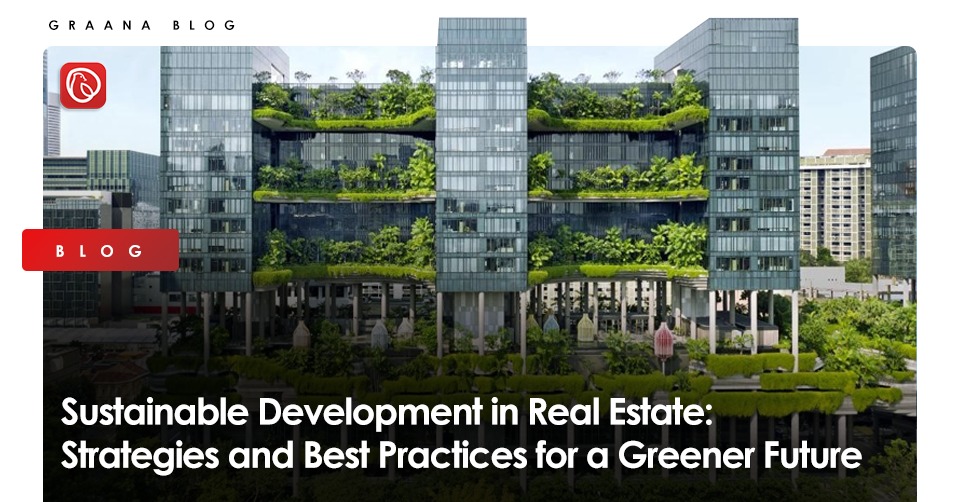
Sustainable development, especially sustainable development in real estate, has become a buzzword in the contemporary world.
As the stories of development unfold around the world, the word ‘sustainable development’ also resonates alongside these stories. Against this backdrop, the development of the real estate sector is also tied to this new yet old phenomenon. Keeping in view the Sustainable Development Goals (SDGs), the real estate sector can provide a great impetus in the realisation of these goals.
Graana.com brings you ways to further sustainable development in real estate and explores the best practices for a greener future.
Technological developments along with advances in medicine have enhanced life expectancy. As a result, the global population has increased. However, the housing demand has not been at par with the rising population. This has created the housing crisis dilemma and has strained the real estate sector.
There are no two views about it that the only way forward is vertical development – land is scarce and can no longer support the exponential growth in population.
Vertical development is the construction of massive skyscrapers to allow people to habitat them. Instead of clearing forests and agricultural land to make space for urban development, town planners can support the construction of tall buildings to meet housing needs. This way scarce resources can be saved for future generations.
In addition, by developing upwards, farmlands can be saved which will ensure a stable food supply for the rising population. This is crucial for ensuring a stable food supply, especially with the increasing population. By utilizing vertical space, urbanization can occur without compromising the availability of fertile land for farming.
Businesses, contractors and homeowners have realised the importance of sustainable development and are switching to green construction materials to minimise the environmental impact.
On the flip side, there are also monetary benefits to going green. Utilising green materials results in energy-efficient buildings, decreases the carbon footprint and acts as a great marketing tool by boosting public perception towards environmentally friendly practices.
Some examples include the use of bamboo, reclaimed wood, cork, mycelium, ferrock and recycled steel etc. These materials are easy to source and are cheaper to utilise. They bring down the overall construction costs too!
From solar energy to wind energy, clean energy is the solution to all energy-related problems – climate, development and population. Renewable energy is derived from sources of energy that can be naturally replenished without stressing the existing resources.
With the advances in technology, humans have been able to use renewed energy sources like sun, water, wind to produce energy; not only are these green sources of power, but these are also cost-efficient in the longer run.
For example, solar energy is expensive to install but people are able to recover the initial installation cost within five years. Hence, within a few years, the users are able to enjoy cheap power to meet their daily needs.
With the current economic crisis in Pakistan, it is important that those who can afford it should switch to solar energy to cut down their costs in the long run. This could be one of the ways to beat inflation.
Recycling and reusing are other dimensions of sustainable living in real estate. It is related to solid waste management in properties.
Recycling refers to the alternative use of the same product to use it in creative ways while reusing refers to the repeated use of the same product without changing its form.
This minimises the damage to the environment by sustainably repurposing the waste in meaningful ways in order to extend its life without the need to dispose of them.
Recycling and reusing materials in real estate development can have a significant impact on sustainability. By repurposing existing structures or materials, the environmental impact of new construction can be reduced.
Additionally, recycling construction waste reduces the amount of material that ends up in landfills. Incorporating recycling and reuse into real estate development can help to create a more sustainable future for both the industry and the planet.
There is no doubt about the fact that water is a scarce resource. Major cities of the world are already facing a water crisis. With global warming and a lack of planning, pure water is increasingly becoming a luxury. In a few years’ time, the situation will worsen if active steps are not taken.
Dams and reservoirs can be built to store water but that is a luxury only the developed nations can easily afford because it has a hefty price tag.
An alternative is also available – rainwater harvesting. Rainwater harvesting is the system of collecting rainwater and treating it to make it available for everyday use.
By capturing and storing rainwater, it can be used for various purposes such as irrigation, flushing toilets, and washing clothes. This can reduce the demand on freshwater resources and help to conserve them.
Moreover, rainwater harvesting can mitigate the impact of droughts and floods, which are becoming increasingly common due to climate change.
By implementing rainwater harvesting systems, we can create a more sustainable and resilient water supply for future generations.
ISLAMABAD: The Capital Development Authority (CDA) has recorded a historic development expenditure of Rs25 billion…
ISLAMABAD: The federal government is set to inaugurate the Islamabad Information Technology Park on August…
Lahore, April 23, 2025 – The city of Lahore has successfully completed the construction of…
ISLAMABAD, Pakistan – April 23, 2025 – Chaaye Khana, Pakistan's popular cafe renowned for its…
ISLAMABAD: Prime Minister Shehbaz Sharif laid the foundation stone for the Murree Road underpass on…
DUBAI: Pakistani real estate developers and representatives showcased a range of commercial and residential investment…